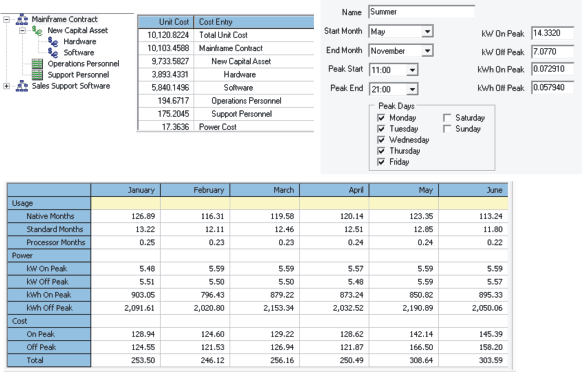Mirror Physical Resources
The purpose of the
Resource Catalog is to
provide intuitive definition
and control of the
information needed for
intelligent costing. The
content mirrors the
business’s physical IT
resources and the costs
associated with them.
Service Costing Inventory
The Resource Catalog
defines the inventory and
the associated costs that
are going to be used for
Service Costing. When the
incoming performance
information is processed,
the Resource Catalog
provides the related unit
costs for the data.
Basis for SOA
The inherit framework
used for all processing
within RG Solutions® is
based on a Software
Oriented Architecture. In
this framework, there are
different functions for
different type of systems.
The Resource Catalog
supports the diversity
required for processing
cost data within an SOA
framework.
The Resource Catalog is the basis of all processing in RG Solutions®. It defines the resources to be
measured, the characteristics of the resources, the various costs associated with IT operations, and
the linking of these costs to the resources. The Resource Catalog provides the foundation for the
integration of financial and performance data.
Data Centers
A Data Center in the Resource Catalog is like the actual data center that houses the system
processing. It has properties that define the environmental attributes of the actual data center such
as electrical rates, power costs, and other considerations. For other unique costs related to the data
center, the processing allows for the use of Cost Pools that distribute costs to the various processing
components.
RG Solutions® also allows for the setting of unit prices associated with a data center. The unit
prices are date based (so as to allow for different rate schemes) and provide the default values that
will be used in the processing should the processing item not be associated with any particular cost
pools.
Cost Pools
Cost Pools within the Resource Catalog are dynamic in nature and allows for a structured approach to
the formation of the unit costs. Each entry is based on a date range that defines the life of the cost,
and these dates are used by the processing to determine the unit costs for a particular date.
The types of costs permitted for a cost pool are not limited, but generally fall into two categories:
Capital Asset and Expense. The Capital Asset cost is typically a major investment that is expected to
have a life of more than one year, and the Expense cost is typically for a particular year. (RG
Solutions® allows for automatic expensing based on a percent of annual growth). Associated costs of
a Capital Asset can be either included as part of the Capital Asset or as a related expense.
Resources
There are two types of Resources used within the Resource Catalog: System and Workload. A
System Resource is the catalog representation of a single physical system such as a mainframe or
standalone server. These resources have different processing characteristics such as processor
speed, system architecture, processing behavior, and the types and numbers of applications
processing on it. The costs associated with the System Resources are generally those cost associated
with the actual physical system.
A Workload Resource is a unique application (i.e. Oracle, Exchange, etc.) that is running on one or
more System Resources. The costs associated with Workload Resources are generally those costs of
a particular application (i.e. software acquisition, training, support, etc). Similar workloads can be
grouped together for cost sharing.
The Resource Catalog has many supporting capabilities that allow for the management of the
resources. One of the major capabilities is the ability to forecast usage for both systems and
workloads based on actual data and a user growth estimate. This and other information in the catalog
can be used for Capacity Planning and other business methods to manage operational processing.


